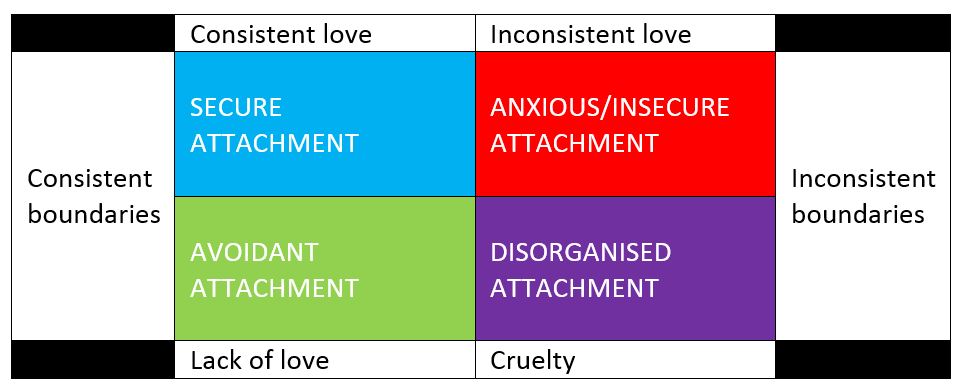
Attachment and depression/anxiety
In my counselling work, I’ve noticed a strong correlation between adults struggling with long-term depression and/or anxiety, and attachment issues from their childhood.
‘Attachment’ is a term used to describe the relationship a child develops with their primary caregiver. The theory of attachment was originally developed by John Bowlby (1907 – 1990), a British psychoanalyst who was attempting to understand how different parenting styles impacted on the behaviour and emotional states of their children (Fraley, R.C, 2018).
Bowlby identified four main types of attachment; secure, anxious/insecure, avoidant, and disordered:

A child with secure attachment (a loving, structured environment) will move away from his parent in order to explore his physical and social world and will regularly come back to his parent to ‘check in’ and then move away again. He will generally develop a sound sense of self, and relate well with others.
Insecure/anxious attachment is a relationship style where the parent-child bond is a loving relationship contaminated by fear. A child with insecure attachment might be clingy and obsessed with her parent, concerned that she might be abandoned, or at times lose the love of her parent.
Parents of children with an avoidant attachment tend to be emotionally unavailable to their children much the time. In response, the avoidant attached child learns early in life to suppress the natural desire to seek out a parent for comfort when frightened, distressed, or in pain (Catlett, J, 2019).
Disorganised attachment is a bond that is typical of children who have suffered abuse from their caregiver. These children never know what to expect from the people who are supposed to protect them (Exploring Your Mind, 2019). These children can develop and display an array of distressing coping behaviours such as deceit, stealing, rage, depression, anxiety, and/or emotional shutdown.
Children with attachment issues often develop into adults with relational and emotional issues. As a counsellor, I have worked with children with disorganised attachment, and I have supported both child and adult clients to uncover and identify dysfunctional relating and explanatory styles, as the first step in developing new, healthy neural pathways. This is achieved by guiding them to challenge their inner dialogue, and to replace their automatic catastrophising thoughts to, conscious, specific and functional self-talk. Clients (children and adults) are also encouraged to become more assertive, and to use emotional intelligence, mindfulness and meditation strategies to empower them to create a positive, self-image where they feel increasingly equipped to face life with purpose, hope, strength, equanimity and love.
references
Catlett, J, 2019, Psychalive
https://www.psychalive.org/anxious-avoidant-attachment/
Exploring Your Mind, 2019
https://exploringyourmind.com/insecure-attachment-3-different-types/
Fraley, R.C, 2018
http://labs.psychology.illinois.edu/~rcfraley/attachment.htm
Pearce, C, Jessica Kingsley Publishers, UK, 2009
Attachment and Attachment Disorder